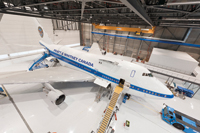
Features
Operations
At the Gate: Banking on the CSeries
There was a grand ceremony in early May to launch Pratt & Whitney Canada’s $360-million, 300,000-square-foot engine assembly plant and test centre at Mirabel Airport north of Montreal.
July 6, 2011 By Brian Dunn
There was a grand ceremony in early May to launch Pratt & Whitney Canada’s $360-million, 300,000-square-foot engine assembly plant and test centre at Mirabel Airport north of Montreal. All the bigwigs were there, including Quebec premier Jean Charest, Louis Chênevert, chairman and CEO of United Technologies Corp., which is P&WC’s parent company, and P&WC president John Saabas.
The plant will assemble and test the PW1524G engine for Bombardier’s CSeries aircraft, the PW800 family of engines for the next generation of large business jets and GTF engines for other aircraft in various stages of development. There’s a lot riding on the CSeries to make the plant viable.

|
In a note to clients, analyst Richard Aboulafia of Teal Group in Fairfax, Va., questions the long-term success of the CSeries, calling it an “enormous gamble. With Airbus accelerating the A319 Neo and going after Republic (Airlines), there’s a risk the CSeries remains a marginalized product.”
But Pratt & Whitney president David Hess of Hartford, Conn., scoffs at suggestions the CSeries is a lame duck, noting it has a great number of attributes, including great economics. Such sentiment must be spreading, as Bombardier had confirmed eight firm orders for CSeries by the end of June – including three at the Paris Air Show.
Another possible candidate for the Mirabel plant, which is located next to the mothballed airport (except for cargo and private aircraft), is the final assembly for a larger GTF engine that will power the Airbus A320 Neo. Hess says a decision where to build the engines will be made “sometime this year.” Snagging the Neo work would be a real coup for P&WC as Airbus expects to sell some 4,000 of the aircraft over a 10- to 15-year period.
The Mirabel plant received $250 million in financial aid from Quebec, half in the form of loans, in addition to federal government money. But Saabas was quick to point out that P&WC has spent $8 billion in R&D since 1982 and is spending another $2 billion over the next five years.
Getting back to Bombardier, Aboulafia points to a recent wave of China-bound aircraft programs, including Embraer’s decision to build its Legacy 600/650 business jets in that country and China’s purchase of Teledyne Continental Motors and some rights to bankrupt Epic Aircraft.
But Bombardier’s agreement with COMAC of China intrigues him the most. He says the two companies will consider aircraft commonality and joint sales initiatives, but no concrete steps have been announced.
“Some have posited this MoU (memorandum of understanding) as a harbinger of an emerging player alliance, one that could challenge the Airbus and Boeing duopoly. But the reality is that COMAC and Bombardier have considerable product overlap and there is nothing to discuss. In fact, the latest agreement follows a previous MoU that went nowhere,” says Aboulafia.
He is referring to the 2007 Paris Air Show where Aviation Industries of China agreed to build the CSeries fuselage, and Bombardier agreed to help AVIC develop a 90/140-seat ARJ21-900. And since then, China hasn’t ordered a single CSeries aircraft and the ARJ21-900 “looks dead.”
On the delivery front, Bombardier saw the value of its deliveries of business aircraft decline 16.5 per cent in the first quarter, slightly better than the industry average. According to the General Aviation Manufacturers Association (GAMA), the total value of all shipments of business and private aircraft of US $3.73 billion was down 19.6 per cent from the year earlier period.
During the first quarter, the value of Bombardier’s business aircraft deliveries reached $1.3 billion versus $1.5 billion a year earlier. The company delivered more Learjets, but fewer of the larger Challengers and Global Express aircraft. In total, Bombardier delivered 42 business aircraft versus 47 a year ago.
The Montreal-based company still remains the most important player in the industry, ahead of Gulfstream, which delivered $1.05 billion worth of business aircraft during the quarter, and Dassault Falcon, which delivered $407.2 million.
Joseph B. Nadol III of Wall Street’s J.P. Morgan says in a report that Bombardier’s worst days are behind it and figures it will pick up 10 more orders this year than last, to 160 units, but mostly in the lower-margin Learjet division.
Brian Dunn is a Wings writer and columnist.